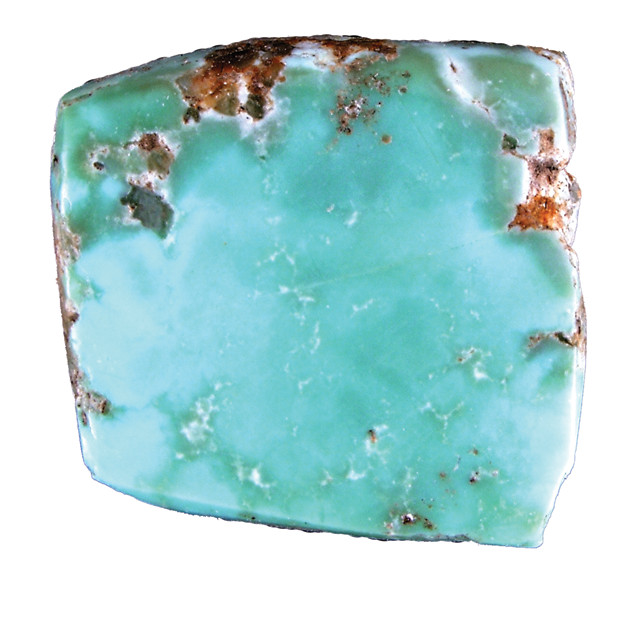
by Mara Johnson-Groh Wednesday, January 10, 2018

This turquoise mosaic piece from a precolonial site in Arizona has isotope ratios consistent with geologic samples from Canyon Creek. Credit: Saul Hedquist.
Few minerals are more iconic in the Desert Southwest than turquoise. The blue-green gemstone, which offers a stark contrast to the dusty red southwestern deserts, has been coveted for thousands of years by indigenous peoples, conquering Spaniards and now by a growing market around the world. Despite its past and present cultural significance, especially among indigenous populations, little is known about the early history of turquoise mining. Researchers have now uncovered previously unknown details about a historic turquoise mining site in Arizona that suggest it was more prolific than once thought.
The chemical makeup of turquoise, which forms through slow weathering in bedrock near copper ores, reflects the surrounding geology. In particular, the isotopic makeup of certain impurities in turquoise, like lead, acts like a chemical fingerprint, allowing different samples to be traced to the locations where they were mined.
Turquoise from the Canyon Creek mine, located on the White Mountain Apache Indian Reservation in east-central Arizona, was particularly interesting to Saul Hedquist, a recent doctoral graduate from the School of Anthropology at the University of Arizona, and his colleagues. In recent years, they have been combining geochemistry and archaeology to uncover the pre-Hispanic history of turquoise mining and trade.
“This turquoise occurs within seams of very old sedimentary rock, and it’s in a region that also contains geologically old uranium deposits,” says Alyson Thibodeau, a geochemist at Dickinson College in Pennsylvania and a co-author of a new study, published in the Journal of Archaeological Science. “That uranium-rich environment makes the lead isotope signature [of Canyon Creek turquoise] very distinctive.”
The team collected turquoise samples from the Canyon Creek mine with permission from the White Mountain Apache Tribe, whose help was instrumental in the study’s success. Analyzing the samples’ lead and strontium isotopes, the researchers found that lead signatures varied over short distances, with samples from quarries just 100 meters apart having slightly different isotopic ratios.
They then compared the Canyon Creek signatures with those from turquoise artifacts from around the region to assess the mine’s importance in the ancient turquoise trade. The results showed that Canyon Creek was much more productive than previously thought and that its turquoise was widely traded to distances more than 100 kilometers away. Using archaeological records from the locations where the Canyon Creek turquoise ended up, the researchers also found that the mine was active during the 13th and 14th centuries.
“Beyond the isotope analysis, our documentation of the mine itself — its physical characteristics and morphology — was extremely detailed,” Hedquist says. “This allowed what we think to be pretty accurate estimates of the mine’s original size and output.”
By measuring the size of tailings piles at the mine, the researchers estimated that more than 10,000 cubic meters of rock were excavated over the years.
Using geochemistry to identify artifacts that came from Canyon Creek also offered a window onto the site’s significance in ancient indigenous cultures. “It appears turquoise from this mine was made into tesserae mosaic pieces” for use in ornaments and mosaic designs, Thibodeau says. “That may partially be a result of the fact that this turquoise forms very small pieces, occurring in such small little seams.”
The researchers say that, after the success of this work, similar efforts are underway to analyze turquoise artifacts from other mines.
© 2008-2021. All rights reserved. Any copying, redistribution or retransmission of any of the contents of this service without the expressed written permission of the American Geosciences Institute is expressly prohibited. Click here for all copyright requests.